"Get ready to ace your CBSE Class 10 Science Chapter 10 with our essential guide to 'The Human Eye and The Colourful World'! As the 2024-25 board exams approach, we've compiled a set of vital questions and expert answers to help you conquer this crucial topic. Dive in to boost your understanding and confidence for the exams ahead!"
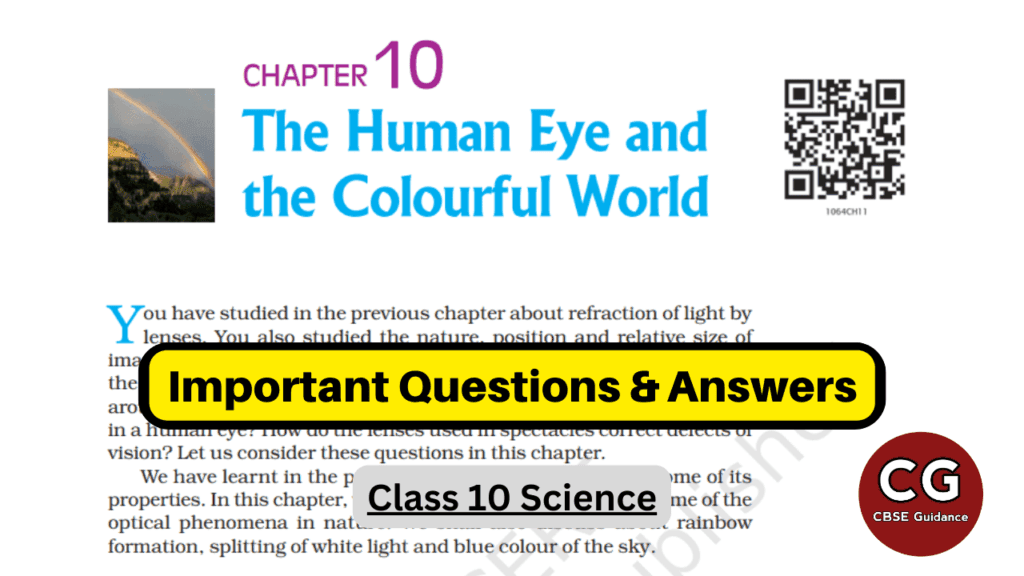
| Subject | Science |
| Class | 10 |
| Board | CBSE & State Boards |
| Chapter No. | 10 |
| Chapter Name | The Human Eye and the Colourful World |
| Type | Important Questions & Answers |
| Session | 2024-25 |
"Success isn't overnight. It's when everyday you get a little better than the day before. It all adds up."
- Dwayne Johnson
The Human Eye and the Colorful World Important Questions and Answers
Q. No. 1) Multiple Choice Questions (MCQs)
i. Which of the following statements is correct regarding the propagation of light of different colors of white light in the air?
a. Red light moves the fastest
b. Blue light moves faster than green light
c. All the colors of the white light move with the same speed
d. Yellow light moves with the mean speed as that of red and violet light
Ans. Option c.
ii. Consider the following statements about dispersion by glass prism:
- The splitting of light into its component colors is called dispersion.
- Isaac Newton was the first to observe dispersion.
Choose the correct option from the codes given below:
a) Only 1
b) Only 2
c) Both 1 and 2
d) Neither 1 nor 2
Ans. Option c.
iii. At noon sky appears white because
a) Light is least scattered
b) All colors get scattered equally
c) Blue color scatters the most
d) Red color scatters the most
Ans. Option b.
iv. Which of the following are the effects of atmospheric refraction?
- Twinkling of stars.
- Tyndall effect.
- Advance sunrise and delayed sunset.
Choose the correct option from the codes given below:
a) 1 and 2
b) 2 and 3
c) 1 and 3
d) 1, 2 and 3
Ans. Option c.
v. The colored band of light obtained by dispersion of light is called:-
(a) Tyndall effect
(b) Dispersion
(c) Spectrum
(d) Refraction
Ans. Option c.
vi. A prism causes
a) Only dispersion
b) Only deviation
c) Both dispersion and deviation
d) Neither dispersion nor deviation
Ans. Option c.
vii. A prism is a transparent medium that has ______ triangular bases and _______ rectangular lateral surfaces.
a) Two, three
b) Three, two
c) One, two
d) Two, four
Ans. Option a.
viii. The bluish color of water in the deep sea is due to:
a) The presence of algae and other plants found in water
b) Reflection of the sky in the water
c) Scattering of light
d) Absorption of light by the sea
Ans. Option c.
ix. Dispersion of light by glass prism is shown in the figure. Here X and Y indicate ________ and ______ colors respectively.
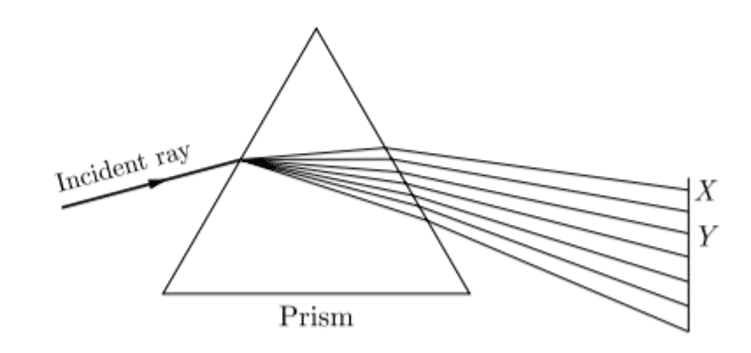
a) Red, blue
b) Red, indigo
c) Red, yellow
d) Violet, green
Ans. Option c.
x. Which of the colors of visible light has minimum frequency?
(a) Violet
(b) Red
(c) Yellow
(d) Green
Ans. Option b.
(* Red color light has the lowest frequency and the longest wavelength of the visible colors of light.)
xi. The order of the wavelength of red, yellow, and orange is
(a) yellow < orange < red
(b) yellow > orange > red
(c) orange > red > yellow
(d) none of these
Ans. Option a.
xii. When starlight enters the earth’s atmosphere:
(a) it bends away from the normal.
(b) it bends towards the normal.
(c) it first bends towards the normal and then away from the normal.
(d) it first bends away from the normal and then towards the normal.
Ans. Option b.
xiii. If a beam of red light and a beam of violet light are incident at the same angle on the inclined surface of a prism from air medium and produce angles of refraction r and v respectively. Which of the following is correct?
a. r = v
b. r > v
c. r = 1/v
d. r < v
Ans. Option (b)
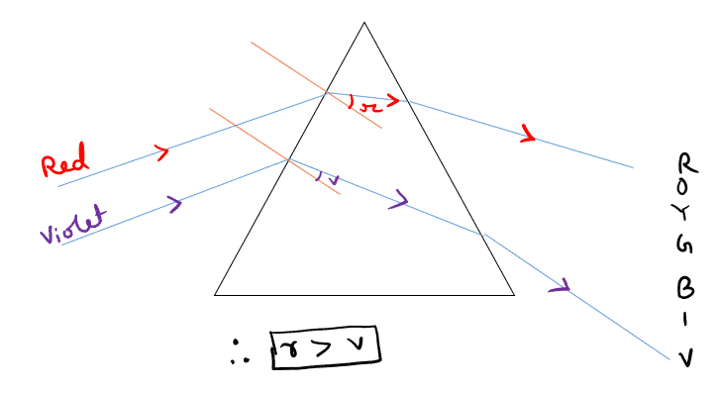
xiv. A prism ABC (with BC as the base) is placed in different orientations. A narrow beam of white light is incident on the prism as shown in the below figure. In which of the following diagrams, after dispersion, the third colour from the top of the spectrum corresponds to the colour of the sky?

a. (i)
b. (ii)
c. (iii)
d. (iv)
Ans. Option (b)
Q. No. 2) Draw a neat labeled diagram of the structure of the human eye and mention the functions of any four parts.
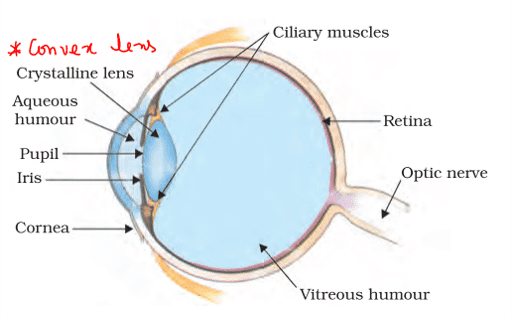
Ans.
- a. Cornea: A thin membrane that covers the eyeball and allows the light to enter and refracts the light to focus it at the crystalline lens.
- b. Eye Lens: It is a convex lens. It provides the finer adjustment of the focal length required to focus objects at different distances on the retina.
- c. Iris: It controls the size of the pupil.
- d. Pupil: It regulates and controls the amount of light entering the eye.
- e. Retina: It contains light-sensitive cells that get activated upon illumination and generate electrical signals.
- f. Ciliary muscles: Modifies the curvature of the eye lens, thereby changing the focal length of the eye lens.
Q. No. 3) (a) Rupal suffers from myopia. Where would the image form in her eye?
(b) Name the type of lens that is generally used to correct myopia.
(c) Rupal underwent cataract surgery and her eye lens was replaced with an artificial lens with a fixed focal length, made of a plastic material, silicone. State one likely visual disadvantage that Rupal is likely to experience as compared to a person who has normal eyesight.
(d) Identify the parts of the eye labeled in the diagram from the descriptions given below by writing the labels as your answer.
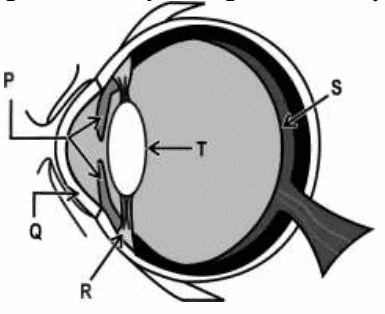
(i) It helps in changing the focal length of the lens.
(ii) It causes most of the refraction of the light entering the eye.
(iii) It controls the amount of light entering the eye.
(iv) It acts as a screen on which the image is formed.
Ans. a. in front of the retina
b. concave lens
c. The person would not have the power of accommodation.
d. (i) R
(ii) Q
(iii) P
(iv) S.
Q. No. 4) Name the part of the eye where the image is formed by the eye lens. What is the nature of the image formed? How is this image sent to the brain?
Ans. Retina.
The image on the retina is inverted and real.
The light-sensitive cells in the retina get activated upon illumination and generate electrical signals. These signals are sent to the brain via the optic nerves.
Q. No. 5) a. Which liquid fills the space behind the cornea?
b. Which liquid fills the space between the eye lens and the retina?
Ans. a. Aqueous humour is filled in the space behind the cornea.
b. Vitreous humour fills the space between the eye lens and the retina.
Q. No. 6) Why does it takes some time to see objects in a cinema hall when we just enter the hall from bright sunlight? Explain in brief.
Ans. The pupil regulates and controls the amount of light entering the eye. In bright sunlight, the size of the pupil is small and when we enter the cinema hall it takes some time for the pupil to expand in size due to dim light.
Q. No. 7) a. What is ‘power of accommodation' of the eye? Name the component of the eye that is responsible for the power of accommodation.
b. What happens to the image distance when the object being viewed is moved away from the eye?
Ans. a. The ability of the eye lens to adjust its focal length is called the power of accommodation.
The ciliary muscles of the eye are responsible for the change in its focal length.
b. Image distance remains fixed which is equal to the distance between the retina and the eye lens.
Q. No. 8) Calculate the maximum power of accommodation of a person having normal vision.
Ans. For normal vision,
Near point = 25 cm = 25/100 m = ¼ m
Therefore,
Maximum Power of accommodation (P) = 1/f = 1/(1/4) = 4 D
Q. No. 9) What is the range of vision for a normal human eye?
Ans. 25 cm to infinity.
Q. No. 10) A person suffering from an eye defect uses a lens of power -1D. Name the defect he is suffering from and the nature of the lens used.
Ans. He is suffering from myopia (near-sightedness) and he is using a concave lens (negative power).
Q. No. 11) What is presbyopia? State the causes of this defect. How is the presbyopia of a person corrected?
Ans. The power of accommodation of the eye usually decreases with ageing. For most people, the near point gradually recedes away. They find it difficult to see nearby objects comfortably and distinctly without corrective eye glasses. This defect is called Presbyopia. Sometimes, a person may suffer from both myopia and hypermetropia.
Causes of Presbyopia:
- Gradual weakening of the ciliary muscles.
- Diminishing flexibility of the eye lens.
Correction of Presbyopia:
People suffering from both myopia and hypermetropia often require bi-focal lenses. A common type of bi-focal lens consists of both concave and convex lenses. The upper portion consists of a concave lens. It facilitates distant vision. The lower part is a convex lens. It facilitates near vision.
Q. No. 12) An old person is unable to see clearly nearby objects as well as distant objects.
i. What defect of vision is he suffering from?
ii. What kind of lens will be required to see clearly the nearby as well as distant objects? Give reason.
Ans. i. He is suffering from Presbyopia.
ii. Person suffering from both myopia and hypermetropia often requires bi-focal lenses. A common type of bi-focal lens consists of both concave and convex lenses. The upper portion consists of a concave lens. It facilitates distant vision. The lower part is a convex lens. It facilitates near vision.
Q. No, 13) a. Explain how a normal human eye is able to see distinctly the object placed at a distance as well as those placed at a nearer distance.
b. What are the far point and near point of a normal human eye?
c. What are the far point and near point of a person suffering from hypermetropia?
Ans. a. Ciliary muscles change the curvature of the eye lens as per the requirement of the eye. This changes the focal length of the eye lens. When the muscles are relaxed, the lens becomes thin and distant objects are seen clearly. While seeing closer objects, muscles contract, which thickens the eye lens, and focal length decreases. This enables us to see nearby objects clearly.
b. For normal vision:- Far point = Infinity, Near point = 25 cm
c. For a person suffering from hypermetropia:- Far point = Infinity, Near point = Beyond 25 cm.
Q. No. 14) A 14-year-old student is not able to see clearly the questions written on the blackboard placed at a distance of 5 m from him.
a. Name the defect of vision he is suffering from.
b. Draw ray diagrams to illustrate the image formation of the blackboard when he is seated at the (i) back seat and (ii) front seat.
c. Draw the diagram to show how this defect can be corrected.
d. Name the type of lens used to correct this defect.
e. Name two possible causes of this defect.
Ans. a. Myopia.

b. i.

ii.

c.
d. Concave lens
e. Causes of Myopia:
- Excessive curvature of the eye lens.
- Elongation of the eyeball.
Q. No. 15) A person cannot see objects distinctly when placed at a distance of less than 50 cm.
a. Identify the defect of vision.
b. Give two reasons for this defect.
c. Calculate the power and nature of the lens he should be using to see clearly the object placed at a distance of 30 cm from his eyes.
d. Draw the ray diagrams for the defective and the corrected eye.
Ans. a. Hypermetropia.
b. Causes of hypermetropia:
- The focal length of the eye lens is too long.
- The eyeball has become too small.
c. u = - 30 cm
v = - 50 cm
By lens formula,
1/f = 1/v - 1/u = 1/(-50) - 1/(-30) = 1/(-50) + 1/30 = (-3+5)/150 = 2/150 = 1/75
⇒ f = 75 cm = 75/100 m
∴ P = 1/f = 1/(75/100) = 1.33 D
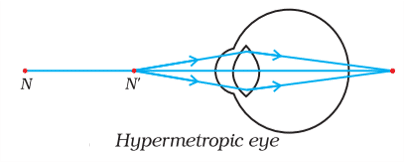
d.
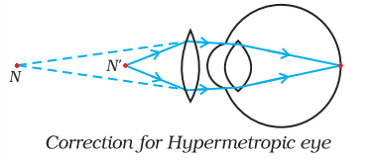
Q. No. 16) If a person wears a lens of power – 6 D for distant vision and for correcting his near vision he needs a lens of + 2 D. Determine the focal length of the lenses in both cases.
Ans. For distant vision:
P = 1/f
f = 1/P = 1/-6 = - 0.1667 m = - 16.67 cm
For near vision:
P = 1/f
f = 1/P = 1/2 = 0.5 m
Q. No. 17) The far point of a myopic person is 150 cm in front of the eye. Calculate the focal length and the power of a lens required to enable him to see distant objects clearly.
Ans. u = ∞
v = -150 cm
By lens formula,
1/f = 1/v - 1/u = 1/(-150) - 1/∞ = 1/(-150) - 0= (-1)/150
⇒ f = -150 cm = -150/100 m
∴ P = 1/f = 1/(-150/100) = - 0.66 D
Q. No. 18) Sunita’s ophthalmologist suggests her to use a lens of power -2 D to correct her vision.
i. What type of lens should she use?
ii. What should be the focal length of the lens?
iii. An object is kept at 10 cm in front of the lens of power – 2 D. Find the distance where the image is produced.
Ans. i. Concave lens/ Diverging lens.
ii. f = 1/P = 1/-2 = -0.5 m = -50 cm
iii. Given, u = - 10 cm
f = -50 cm
By lens formula,
1/v - 1/u = 1/f
⇒ 1/v = 1/f + 1/u
⇒ 1/v = 1/-50 + 1/-10 = -1 - 5/50 = -6/50
⇒ v = -50/6 = - 8.33 cm
Q. No. 19) Draw a neat diagram to show the refraction of a light ray through a glass prism, and label on it the angle of incidence and angle of deviation. Hence define the angle of deviation.
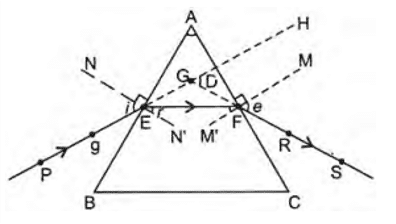
Ans.
PE – Incident ray; ∠i = Angle of incidence
EF – Refracted ray; ∠r = Angle of refraction
FS – Emergent ray; ∠e = Angle of emergence
ÐA = Angle of prism; ∠D = Angle of deviation
The angle of deviation is angle D, between the incident ray and the emergent ray when a ray of light passes through a glass prism.
Q. No. 20) What is the cause of the dispersion of light on passing through a prism?
Ans. The refractive index of the material of a prism is different for different colors of light as different colors have different speeds in the material of a prism.
Q. No. 21) A student observes the below phenomenon in the lab as a white light passes through a prism. Among many other colors, he observed the position of the two colors Red and Violet.
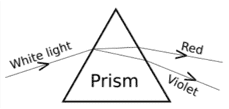
i. What is the phenomenon called? Explain with reference to the diagram, which of the two lights mentioned above will have the higher wavelength.
ii. What is the reason for the violet light to bend more than the red light?
iii. Why do different colors of white light bend at different angles through a prism?
Ans. i. The phenomenon is called dispersion. Red color has a higher wavelength.
ii. Speed of violet light inside the prism is slowest and that of red is highest. Hence, the deviation of violet is maximum and that of red is minimum.
iii. Different colors of white light bend through different angles with respect to the incident beam of light due to differences in the speed of light of different wavelengths.
Q. No. 22) White light is passed through a prism to yield a spectrum.
a. The ray of which color will show the maximum angle of deviation and which one will show the least angle of deviation?
b. A blue-colored ray is passed through a glass prism. What will be the color of the emergent ray? Justify your answer.
Ans. a. Maximum angle of deviation – Violet color ray
Minimum angle of deviation – Red color ray.
b. The emergent ray will be blue in color since the blue color ray cannot be split any further it will pass through the prism undispersed.
Q. No. 23) Two triangular glass prisms are kept together and connected through their rectangular side. A light beam is passed through one side of the combination. Will there be any dispersion? Justify your answer.
Ans. The given setup will behave like a glass slab, resulting in the recombination of the seven colors to produce white light.
Q. No. 24) a. What is meant by dispersion of light? Name the various colors of the spectrum of white light in proper sequence.
b. Describe the formation of the rainbow in the sky.
Ans. a. The splitting of light into its component colors is called dispersion.
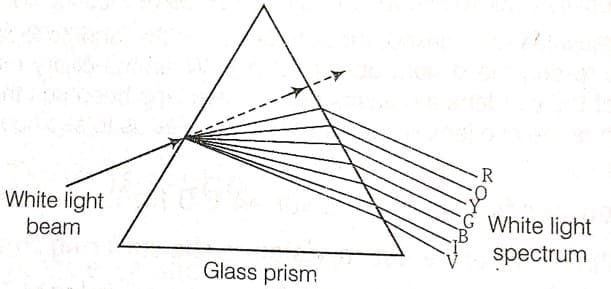
Seven colors of the spectrum are violet, indigo, blue, green, yellow, orange, and red (VIBGYOR)
(*The band of the colored components of a light beam is called its spectrum.)
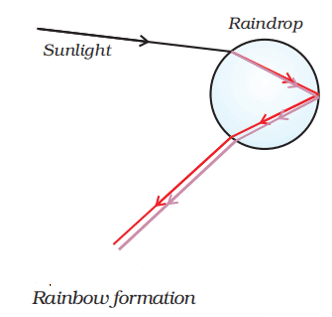
b.
A rainbow is a natural spectrum appearing in the sky after a rain shower. It is caused by the dispersion of sunlight by tiny water droplets, present in the atmosphere. A rainbow is always formed in a direction opposite to that of the Sun. The water droplets act like small prisms. They refract and disperse the incident sunlight, then reflect it internally, and finally refract it again when it comes out of the raindrop. Due to the dispersion of light and internal reflection, different colors reach the observer’s eye.
Q. No. 25) Describe an activity to show that the colors of white light split by a glass prism can be recombined to get white light by another identical glass prism. Also, draw a ray diagram to show the recombination of the spectrum of white light.
Or,
How will you use two identical prisms so that a narrow beam of white light incident on one prism emerges out of the second prism as white light? Draw the diagram.
Ans. 
A glass prism is used to obtain a spectrum of white light and a second identical prism in an inverted position with respect to the first position is used. The angle of deflections of the two identical prisms needs to be equal and opposite. While the first prism splits the light in the seven colors due to different angles of deflections, the second prism combines the spectrum along a single ray and the colors again combine to give white light as the emergent light.
Q. No. 26) Savera passed a beam of white light through a series of equilateral prisms as shown

(a) What color (s) will be seen on the screen?
(b) Copy the diagram above and draw the beam entering Prism 1 and emerging from Prism 3 and falling on the screen.
(c) Name all the processes that take place when the beam of light enters Prism 1 and emerges from Prism 3.
Ans. a. VIBGYOR
- violet
- indigo
- blue
- green
- yellow
- orange
- red
b.
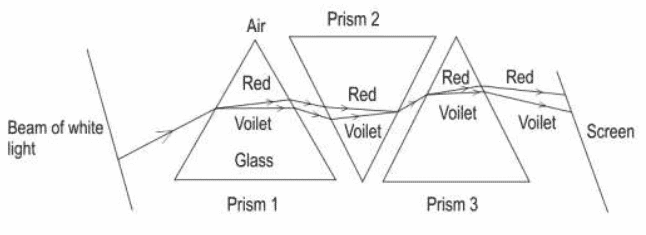
c.
- dispersion
- refraction
Q. No. 27) Why does the sun appear white at noon?
Ans. The sun appears white at noon because the light is least scattered at noon.
Q. No. 28) a. With the help of a suitable diagram explain why the Sun is visible to us two minutes before the actual sunrise and two minutes after the actual sunset.
b. Name the phenomenon responsible for the apparent flattening of the Sun’s disc at sunrise and sunset.
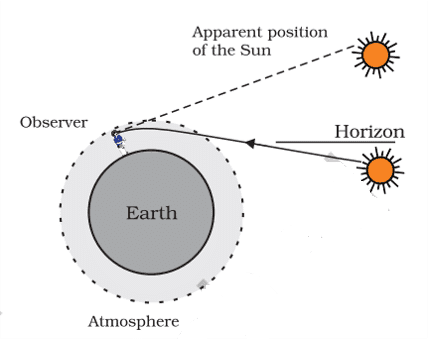
Ans. a.
The Sun is visible to us about 2 minutes before the actual sunrise, and about 2 minutes after the actual sunset because of atmospheric refraction. By actual sunrise, we mean the actual crossing of the horizon by the Sun. The figure below shows the actual and apparent positions of the Sun with respect to the horizon. The time difference between the actual sunset and the apparent sunset is about 2 minutes.
b. Atmospheric refraction.
Q. No. 29) What is meant by the scattering of light?
Ans. Scattering of light is the phenomenon due to which light gets deflected by the atoms, molecules, or particles of the medium when light falls on them.
Q. No. 30) What is the Tyndall effect? What is its cause? Explain two phenomena observed in daily life that are based on the Tyndall effect.
Ans. The phenomenon of scattering of white light by colloidal particles is known as the Tyndall effect.
Cause: The tyndall effect is due to the scattering of light by the colloidal particles.
Daily life examples:
i. When sunlight passes through a canopy of a dense forest, the tiny water droplets in the mist scatter light, and the path of light becomes visible.
ii. When a fine beam of sunlight enters a smoke-filled room through a small hole, the smoke particles become visible due to the scattering of light.
Q. No. 31) Why do stars twinkle but not the planets?
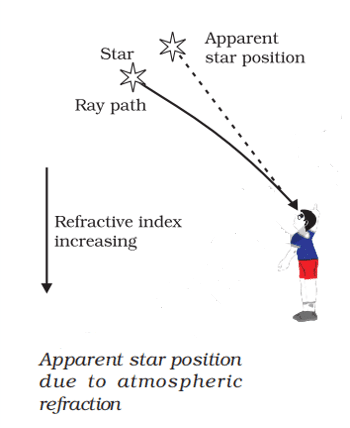
Ans. The twinkling of a star is due to the atmospheric refraction of starlight. The starlight, on entering the earth’s atmosphere, undergoes refraction continuously before it reaches the earth. Since the stars are very distant, they approximate point-sized sources of light. As the path of rays of light coming from the distant star varies slightly, the apparent position of the star fluctuates and the amount of starlight entering the eye flickers that is, the stars sometimes appear brighter, and at some other times, fainter, which is the twinkling effect.
The plants are much closer to the earth and are thus seen as extended sources. Due to this, they appear a combination of large point-sized sources of light, and the total variation in the amount of light entering our eye from all the individual point-sized sources averages out to zero, thereby nullifying the twinkling effect.
Q. No. 32) Is the position of a star as seen by us its true position? Justify your answer.
Ans. No, it's not the actual position of the star. The starlight, on entering the earth’s atmosphere, undergoes refraction continuously before it reaches the earth. The atmospheric refraction occurs in a medium of gradually changing refractive index. Since the atmosphere bends starlight towards the normal, the apparent position of the star is slightly different from its actual position. The star appears slightly higher than its actual position when viewed near the horizon.
Q. No. 33) Why is the color of clear Sky Blue?
Ans. The molecules of air and other fine particles in the atmosphere have sizes smaller than the wavelength of visible light. These are more effective in scattering light of shorter wavelengths at the blue end than light of longer wavelengths at the red end. Thus, when sunlight passes through the atmosphere, the fine particles in the air scatter the blue color (shorter wavelengths) more strongly than red. The scattered blue light enters our eyes and we see the color of the sky as blue.
Q. No. 34) Why does the sky appear dark instead of blue to an astronaut?
Ans. The sky appears dark to an astronaut because the scattering of light is not prominent at such heights.
Q. No. 35) Why are danger signals red in color?
Or,
Why is red used as the stopping light at traffic signals?
Ans. The wavelength of the red color is more. So, it is least scattered by fog or smoke and can be seen from a large distance.
Download Class 10 Science Chapter 10 The Human Eye and the Colourful World NCERT Underlined PDF
| Must Read: The Human Eye and the Colourful World Class 10 Notes Control and Coordination Class 10 Important Questions with Answers |
| You Might Also Like: CBSE Class 10 Notes CBSE Class 10 Important Questions and Answers |
Hope you liked these Questions & Answers on Class 10 Science Chapter 10 Human Eye and the Colourful World. Please share this with your friends and do comment if you have any doubts/suggestions to share.
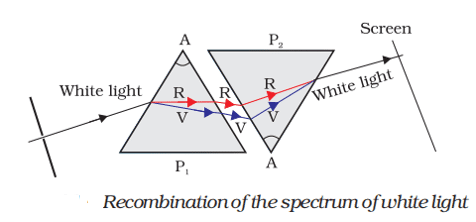


Sir provide other notes also 😔👀
Yes, will update it as soon as possible..
Sir electricity page is not opening I tried several times
Sir your notes is superb.
Kindly post all the science lesson s as soon as possible.
Thank you
Yes I am working on it.
Good evening sir
My question is that ELECTRICITY CHAPTER important question page is not opening
Plz do something sir
Its not opening because its important questions have not been uploaded yet. It will open once I upload it. I am working on it.
Sir light isn’t opening
Yes I will upload it soon.
please provide the underlined pdf
Hi Sir,
Thankyou for the notes of human eye.
I also watch your vedios
Sir in q 37 (human eye)
Why f is -16.66 m
Why not -0.16666 m
Hope you will clarify
Thankyou for your kind support
Ans. For distant vision:
P = 1/f
f = 1/P = 1/-6 = – 16.66 m
For near vision:
P = 1/f
f = 1/P = 1/2 = 0.5 m
Thanks for noticing it. Its my mistake. f should be -0.16666 m or – 16.66 cm. I have corrected it.
Sir.plz upload all important questions of all chapters plzzz sir because exams are soo close
Yes I am working on it.
Sir aap please the colourful eye and the wonderful world and metals and non metals dono chapter ke notes upload kar do
Sir please kar dijiye
how can I get pdf of notes and question answers?
How to Download PDF from CBSE Guidance Website
https://youtu.be/zjocgf0LzUM